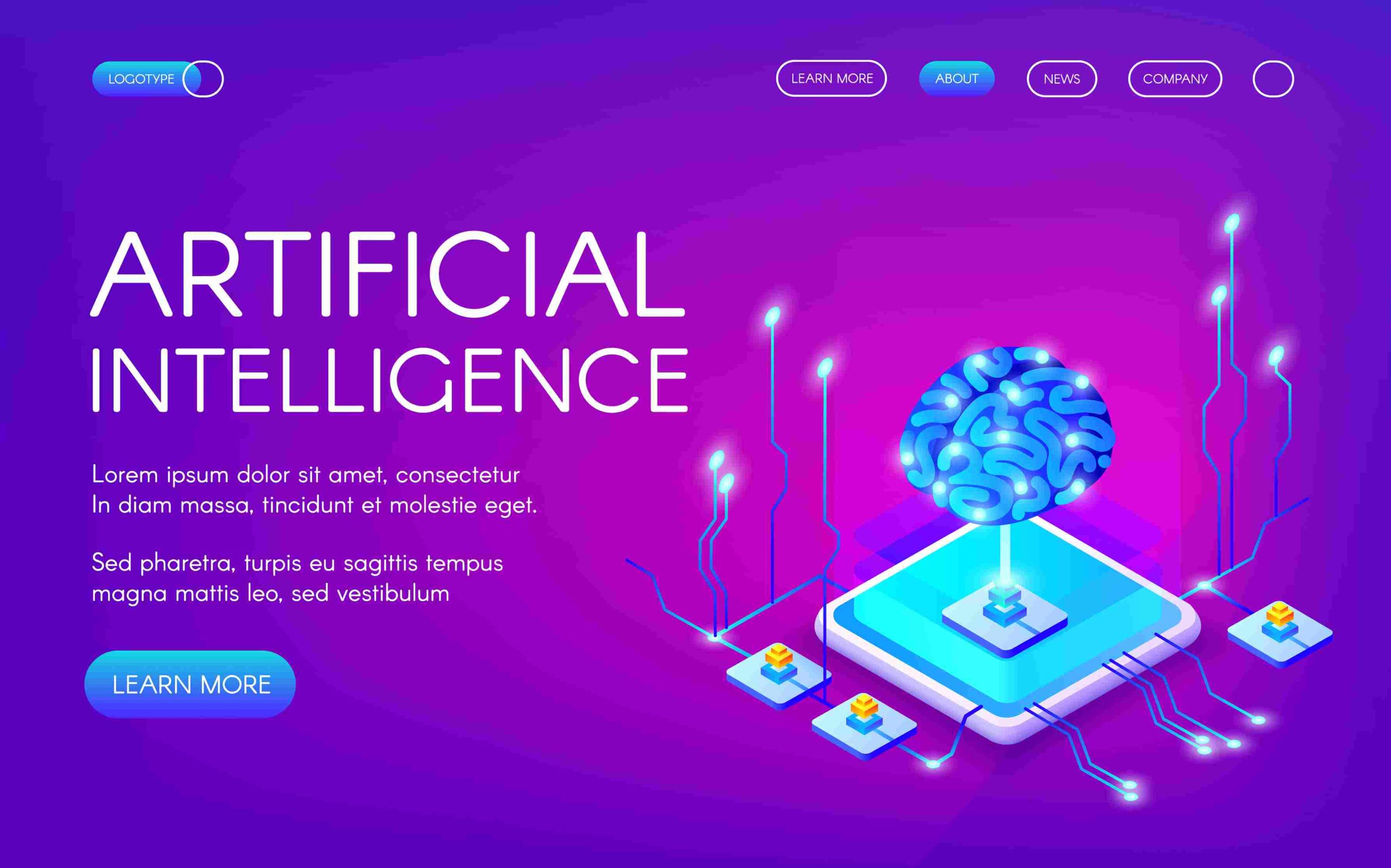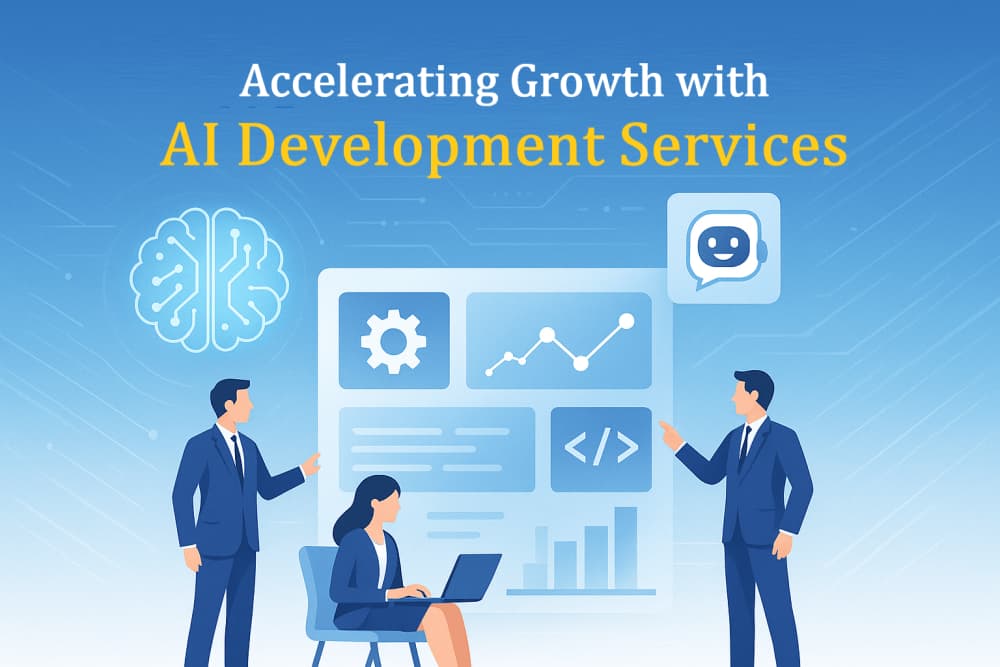AI App Development: Turning Ideas into Intelligent Applications

Introduction
What is AI App Development?
AI app development is the process of integrating artificial intelligence technologies—like machine learning, natural language processing, and computer vision—into mobile or web applications to create software that can learn, adapt, and make decisions. Unlike traditional apps that follow pre-set rules, AI apps can understand context, analyze data, and evolve based on user behavior and real-world inputs.
Imagine an app that recommends your next favorite show, recognizes your voice commands, or predicts when your car might need maintenance. That’s AI at work. It’s not about replacing humans; it’s about enhancing software to be more responsive, efficient, and personalized.
At its core, best AI app development involves gathering relevant data, training algorithms, and building a user interface that seamlessly communicates with the intelligent back-end. Whether it’s a chatbot that learns from conversations or a healthcare app that diagnoses symptoms based on user inputs, the possibilities are limitless.
What makes AI app development particularly exciting today is that the technology is no longer restricted to tech giants. Open-source libraries, accessible cloud platforms, and robust developer communities have made it easier than ever for startups, small businesses, and solo developers to turn innovative ideas into powerful intelligent applications.
Why Intelligent Apps Matter Today
We live in an age where users demand more than just functional apps—they want smart experiences. From personalized shopping suggestions to intelligent route planning and predictive analytics, users are gravitating towards applications that understand their needs and proactively solve problems.
AI-powered apps enhance decision-making, boost productivity, and create seamless user experiences. For businesses, this means increased customer satisfaction, improved operational efficiency, and valuable insights from user data. In fact, companies that leverage AI see a marked improvement in user retention and revenue growth.
Moreover, in today’s data-rich environment, businesses are swimming in information. AI helps them make sense of it. An intelligent app can analyze user behavior, spot trends, and provide actionable feedback in real time, helping both businesses and consumers stay one step ahead.
AI is no longer optional; it’s a competitive edge. Companies across industries—from healthcare to finance to e-commerce—are investing in AI to create apps that not only work but think.
Ideation Stage: Planting the Seeds
Spotting the Problem Worth Solving
Every successful AI app starts with a clear, meaningful problem. This could be an inefficiency in customer service, a gap in market forecasting, or a manual process that’s ripe for automation. The key is to identify a challenge that AI is uniquely positioned to solve.
For example, a startup might notice that online shoppers abandon carts due to irrelevant product suggestions. An AI-powered recommendation engine could solve that. Or perhaps hospitals are overwhelmed with patient data—an app that leverages AI to sort and analyze records can transform how doctors make decisions.
During this stage, brainstorm problems in your industry or daily life that frustrate users or cost businesses time and money. Look for repetitive tasks, prediction needs, or personalization gaps—these are all prime candidates for AI intervention.
Defining Use Cases for AI Integration
Once you’ve identified a problem, map it to specific AI use cases. AI isn’t a one-size-fits-all solution—it comes in many forms, from computer vision to sentiment analysis to recommendation systems. Your goal is to determine how AI will bring value to the app and the user.
Here are some common AI app use cases:
- Chatbots and Virtual Assistants – Automate customer support or onboard new users.
- Recommendation Engines – Suggest content, products, or services.
- Image Recognition – Identify objects, faces, or documents.
- Speech-to-Text – Transcribe conversations or take voice commands.
- Predictive Analytics – Forecast trends, behaviors, or outcomes.
The more clearly you define your AI use case, the easier it becomes to scope out technical requirements, choose the right tech stack, and train your models effectively.
Aligning Business Goals with AI Capabilities
An AI app should do more than just “seem smart.” It should drive measurable business value—whether that’s increasing conversions, reducing costs, improving customer experience, or enhancing productivity.
Start by setting clear KPIs that your AI features will impact. For example:
- Increase product recommendations’ click-through rate by 25%.
- Reduce customer service response time by 40%.
- Improve the accuracy of inventory forecasts to 95%.
These metrics will guide your development process and ensure your AI implementation isn’t just flashy but functional. It also helps you prioritize features during MVP development and demonstrate ROI to investors or stakeholders.
Understanding Core AI Technologies
Machine Learning and Deep Learning
Machine learning (ML) is the foundation of modern AI apps. It enables software to learn patterns from data and improve over time without being explicitly programmed. Deep learning is a subset of ML, using neural networks to solve more complex problems like speech recognition and image classification.
ML is ideal for tasks such as:
- Predicting user behavior
- Classifying emails as spam or not
- Detecting fraudulent transactions
- Forecasting sales or supply needs
By training your model on historical data, you can create an app that gets smarter every time it interacts with users or receives new inputs.
Natural Language Processing (NLP)
NLP allows apps to understand, interpret, and generate human language. Whether it’s text or voice, NLP powers features like chatbots, translation tools, voice search, and sentiment analysis.
An AI app with strong NLP capabilities can read reviews, analyze tone, and respond conversationally—all without human input. Think Siri, Alexa, or any smart assistant—NLP is the brain behind them.
For startups building support tools, education apps, or media platforms, NLP is a game-changer that enables real-time understanding of user intent.
Computer Vision and Image Recognition
Computer vision allows applications to see and interpret images and videos. It’s used for face recognition, object detection, barcode scanning, medical imaging, and even AR filters.
If your app involves uploading photos, scanning ID documents, or analyzing visual content, computer vision is essential. For example, an AI health app might analyze skin conditions using image recognition.
Tools like OpenCV, TensorFlow, and AWS Rekognition make it easier than ever to integrate these capabilities into your app.
Predictive Analytics and Big Data
Predictive analytics uses statistical algorithms and ML to predict future outcomes based on historical data. It helps businesses make smarter decisions, such as:
- Forecasting sales trends
- Identifying churn risks
- Anticipating equipment failure
- Scheduling preventive maintenance
In the age of big data, predictive analytics transforms raw information into foresight. An AI app powered by these capabilities becomes not just reactive, but proactive.
Market Research and Validation
Analyzing Competitors and Market Gaps
Before building anything, you need to scan the landscape. What other apps exist in your space? What AI features do they offer? More importantly, what’s missing?
Conduct a competitor analysis focusing on:
- Features
- User reviews
- Ratings
- Pricing
- Value propositions
Look for patterns in what users love or hate. This can uncover valuable market gaps. For instance, if users complain about generic recommendations, your AI app could focus on hyper-personalization.
Identifying Target Users and Personas
Knowing your audience is crucial for success. Develop detailed user personas based on demographics, behavior, goals, and pain points. Are you targeting busy professionals who need automation? Students who want interactive learning? E-commerce customers who crave customization?
The clearer your understanding of your users, the better you can design your AI app’s features, interface, and tone.
Surveys, interviews, and data from existing platforms (like Google Analytics or social media) can help shape these personas.
Validating the AI App Concept with Real Feedback
Before writing a single line of code, get your concept validated. Share mockups or clickable prototypes with your target audience. Use tools like InVision, Figma, or Adobe XD to create interactive demos.
Gather feedback on:
- Value proposition
- Usefulness of AI features
- Ease of use
- Willingness to pay
Use this input to refine your concept, adjust priorities, and ensure you’re solving a real-world problem, not just building a fancy tool with no users.
Designing an AI-First Application
Planning Data-Driven Architecture
An AI-first app isn’t just about adding an AI feature on top—it’s about architecting your entire application with intelligence in mind from the ground up. That starts with designing a system that treats data as a first-class citizen.
At the core of any AI app lies data ingestion, processing, and feedback loops. You’ll need a pipeline that allows raw data—whether it’s images, voice, text, or structured information—to be collected, cleaned, and transformed into usable training inputs. That data must then be fed into your machine learning models and the results reintegrated into the app interface in real-time.
This demands tight integration between your AI models, backend infrastructure, and user interface. Use a modular architecture where your AI logic is decoupled from your app’s frontend. That way, your models can be updated, retrained, or replaced without disrupting the entire application.
Security and scalability are also essential. Use encrypted databases, comply with privacy regulations like GDPR or CCPA (if applicable), and design for scale. AI models can be computationally expensive, so consider microservices and cloud-based inference solutions to handle spikes in traffic.
Creating User-Centric Interfaces for AI Apps
Just because your app is smart doesn’t mean it has to be complicated. In fact, AI apps must prioritize simplicity, clarity, and trust. Users should always understand what the app is doing and why, especially when it’s making predictions or decisions on their behalf.
Design your UI to guide users gently through intelligent features. For example, if a recommendation engine is suggesting content, explain why: “Because you watched X” or “Based on your activity.” If a chatbot is answering questions, show what data it’s using and give users a fallback option to talk to a human.
Personalization is key. Let users set preferences, control notifications, and give feedback on predictions. Incorporating user feedback helps improve model performance and builds confidence in your app.
Dark patterns and unexplained decisions can erode trust fast, so be transparent, and always prioritize user control and consent when it comes to data and AI behavior.
Building Ethical and Transparent AI Systems
Ethics isn’t just a PR issue—it’s a core part of AI development. Biased algorithms, opaque models, and misused data can damage your brand, violate regulations, and harm users. Building AI systems responsibly means focusing on fairness, transparency, and accountability from day one.
Start by carefully curating your training data. Biased data leads to biased predictions. If your app is for diverse users, ensure your dataset reflects that diversity. Audit your algorithms for bias regularly using tools like Fairlearn or AI Fairness 360.
Transparency also matters. Users deserve to know when they’re interacting with AI, what data the app is using, and how predictions are made. For sensitive use cases like health, finance, or hiring, provide human-readable explanations for decisions and let users appeal or correct outputs.
And don’t forget about security. AI apps often handle personal, behavioral, or biometric data—make sure it’s encrypted, stored responsibly, and never used beyond what was consented to.
By embedding ethical considerations into your AI app’s DNA, you build trust, ensure compliance, and create a product that users—and regulators—will support long-term.
Choosing the Right AI Tech Stack
Frameworks (TensorFlow, PyTorch, etc.)
Choosing the right AI framework can greatly impact the performance, scalability, and flexibility of your intelligent application. Two of the most widely adopted frameworks are TensorFlow and PyTorch.
- TensorFlow, developed by Google, is known for its production-readiness and scalability. It’s ideal for complex deep learning models and works well across platforms—from servers to edge devices.
- PyTorch, backed by Meta (Facebook), is more intuitive for experimentation and rapid prototyping. Many researchers prefer it due to its dynamic computation graph and clean syntax.
Other options include scikit-learn for classical machine learning algorithms, Keras (which sits atop TensorFlow) for easier model-building, and XGBoost for highly optimized gradient boosting tasks.
For NLP tasks, you might explore spaCy, Hugging Face Transformers, or BERT models. For computer vision, consider OpenCV, YOLO, or Detectron2.
Pick your framework based on your AI use case, team skill set, and long-term deployment needs. Prototyping in PyTorch but deploying in TensorFlow is also a common hybrid approach.
Cloud AI Services (Azure, AWS, GCP)
Cloud platforms play a crucial role in AI app development, offering powerful compute resources, storage, and managed services to build, train, and deploy models at scale.
- AWS (Amazon Web Services) provides services like SageMaker for model training, Comprehend for NLP, and Rekognition for image analysis. It’s great for scalable, enterprise-grade applications.
- Google Cloud Platform (GCP) offers AutoML, Vertex AI, and integrations with TensorFlow. GCP is ideal for teams already using Google services or focusing on rapid ML deployment.
- Microsoft Azure offers AI tools like Azure Cognitive Services, Azure Machine Learning, and Bot Services. It’s especially popular with corporate clients and government sectors.
These services reduce the need to manage infrastructure and accelerate time to market. You can start training models, hosting APIs, and deploying inference endpoints with just a few clicks.
Make sure your chosen platform complies with data regulations in your target regions. For instance, if operating in the UAE, you might prefer services with local data centers or hybrid deployment models.
Tools for Training and Deployment
Beyond frameworks and cloud services, you’ll need tools to streamline the training, tuning, and deployment of your AI models. Some key tools include:
- Jupyter Notebooks – For experimentation, visualization, and collaboration.
- MLflow – To track experiments, manage models, and streamline deployment.
- Docker & Kubernetes – For containerized, scalable AI deployments.
- ONNX – To move models between frameworks like PyTorch and TensorFlow.
- Streamlit or Gradio – To quickly build interactive frontends for your models.
Automated ML tools (AutoML) like H2O.ai, DataRobot, and Google’s AutoML can help non-technical teams build effective models without deep data science expertise.
Choosing the right set of tools depends on your app’s complexity, your team’s skillset, and how fast you want to go from prototype to production.
Developing the Minimum Viable Product (MVP)
Defining Core AI Features
The MVP stage is where your idea begins to take tangible form. Rather than trying to build everything at once, focus on one or two core AI features that solve a specific user problem.
Ask yourself: “What is the ONE thing my AI app must do well to prove its value?” This might be predicting a user’s next purchase, summarizing documents, detecting anomalies, or recommending personalized workouts.
Start small but impactful. A chatbot doesn’t need to understand every question—it just needs to handle 80% of customer queries efficiently. Once your MVP delivers value, you can iterate and scale.
Training Initial Models with Sample Data
At this stage, you’ll train your first model using a limited but high-quality dataset. If you don’t have your own data, use publicly available datasets from platforms like Kaggle, UCI ML Repository, or government open data portals.
Clean, preprocess, and split your data into training and validation sets. Choose a simple model architecture, train it, and evaluate performance using metrics relevant to your use case—accuracy, precision, recall, F1-score, or mean squared error.
Remember, your initial model doesn’t need to be perfect. The goal is to demonstrate that your AI idea can work in the real world. You can always retrain and fine-tune later.
Testing AI Performance and User Experience
Your MVP isn’t just about the algorithm—it’s about how users experience that intelligence. Once your model is live, conduct real-world testing to assess:
- Prediction accuracy
- Response time
- User satisfaction
- Model confidence/explainability
Collect feedback, analyze usage data, and iterate fast. Consider implementing A/B tests or launching in a closed beta to validate your MVP’s performance.
Testing is also where you identify potential bias or failure points. If your app performs well for one demographic but poorly for another, that’s a sign you need more balanced training data or better model tuning.
Ultimately, your MVP should prove that your AI app delivers value and give you a foundation to build something bigger and smarter.
Data: The Fuel of Intelligent Apps
Data Collection and Preparation
Without data, your AI app is just a shell. Collecting the right data—at the right volume and quality—is fundamental. Depending on your app, this could involve:
- User interactions
- Historical records
- Third-party APIs
- Open datasets
- Manual labeling
Start by identifying what data you need to power your AI features. Then ensure you collect it legally and ethically. For sensitive data like health records or financial transactions, get proper user consent and adhere to privacy laws.
After collection, the data must be cleaned, normalized, and formatted. Remove duplicates, handle missing values, and standardize inputs. Clean data not only improves model performance, but it also saves hours of debugging down the line.
Ensuring Data Quality and Relevance
Poor data = poor predictions. Always prioritize quality over quantity. Use tools to measure:
- Completeness
- Accuracy
- Consistency
- Timeliness
Also, ensure your data is relevant to your use case. If you’re building a language model for teenagers, don’t train it on academic essays. Context matters, and using inappropriate data can lead to irrelevant or even harmful outputs.
Use domain experts to help validate data assumptions, especially for specialized apps like medical or legal AI tools.
Handling Bias and Privacy
Bias is one of the biggest risks in AI. If your training data reflects social, racial, or gender-based biases, your app might replicate or amplify them. Audit your data regularly, and use fairness metrics to track representation across groups.
For privacy, implement techniques like data anonymization, differential privacy, or federated learning—especially if handling sensitive data. Also, always give users transparency and control over their data.
Ethical data practices don’t just protect users—they build trust and safeguard your brand from reputational or legal damage.
Deployment and Integration
Backend and Frontend Considerations
When it comes to deploying an AI application, it’s crucial to ensure both the backend and frontend are optimized to handle the unique demands of AI models. The backend must efficiently manage data processing, model execution, and API integration, while the frontend should ensure smooth user interaction and feedback collection.
On the backend, choose a scalable architecture. Microservices are often preferred, especially for AI apps, as they allow separate services for model inference, data preprocessing, and authentication. Frameworks like Flask or FastAPI (Python) can help you serve models via RESTful APIs. You may also use TensorFlow Serving or TorchServe to deploy trained models efficiently.
The frontend should be lightweight, intuitive, and provide real-time feedback on AI outputs. Whether you’re building a mobile or web app, the user interface must communicate how the AI operates, especially when delivering predictions, recommendations, or decisions. Use modals, tooltips, and interactive visuals to explain AI behavior.
Security is another crucial factor. Since AI apps handle user-specific data, they use SSL encryption, secure tokens (JWT), and OAuth2 protocols to safeguard communications between the frontend and backend.
In short, the UI/UX must complement the backend intelligence, creating a seamless, intelligent user experience that feels both helpful and natural.
Scaling with APIs and Cloud Infrastructure
As your AI app gains traction, scalability becomes a non-negotiable. AI computations, particularly for inference and real-time predictions, can be resource-intensive. This is where cloud infrastructure and APIs shine.
Cloud providers like AWS, Azure, and Google Cloud offer managed AI services and infrastructure that auto-scale based on traffic and demand. Services like AWS Lambda, Google Cloud Functions, and Azure Functions allow you to deploy serverless functions that automatically scale without managing infrastructure.
Use APIs to modularize your application logic. Model APIs can be hosted separately and consumed by your core app, enabling flexibility in upgrading or retraining models without affecting other parts of the system. With API gateways, you can manage security, throttling, and monitoring with ease.
Also, integrate tools like Kubernetes for container orchestration, allowing you to deploy, scale, and monitor services seamlessly. Horizontal scaling helps manage loads during peak times, ensuring your AI app remains responsive and reliable.
Real-Time Processing and Updates
AI apps often need to process data in real time, especially in sectors like finance, healthcare, and logistics. Whether it’s detecting fraud, monitoring health vitals, or adjusting recommendations on the fly, speed matters.
Real-time AI requires:
- Low-latency APIs
- Fast model inference
- High availability of computing resources
Frameworks like Apache Kafka, RabbitMQ, and Redis Streams can help manage real-time data streams. On the AI side, use lightweight models or edge-optimized versions (e.g., TensorFlow Lite, ONNX Runtime) to reduce processing time.
Continuous updates are also vital. As new data is collected, your AI models should be retrained or fine-tuned periodically. Use MLOps pipelines (with tools like MLflow, Kubeflow, or TFX) to automate versioning, testing, deployment, and monitoring of models, ensuring your app evolves with its users.
Measuring Success and Performance
KPIs for AI Apps
Defining success in AI app development goes beyond downloads and revenue. You need to track AI-specific Key Performance Indicators (KPIs) that reflect both technical performance and user value.
Common AI app KPIs include:
- Model Accuracy – How often predictions match reality.
- Precision/Recall/F1 Score – For classification tasks.
- Latency – Time taken for AI model inference.
- User Engagement Rate – How often users interact with AI features.
- Conversion Rate – Impact of AI on business goals (sales, signups, etc.).
Set benchmarks early, and compare your AI features against these KPIs regularly. If your chatbot’s accuracy is below 80%, for example, it may frustrate users rather than help them.
Using Analytics to Improve Models
Analytics tools provide insights into how users interact with your AI-powered features. This information helps identify areas where your model excels—and where it needs improvement.
Use platforms like Mixpanel, Google Analytics, or custom dashboards to track:
- User drop-off points
- Common mispredictions
- Frequently asked questions (for chatbots)
- Engagement heatmaps
These insights are gold for refining your AI algorithms. For instance, if users are consistently rejecting certain recommendations, you may need to retrain your model with better behavioral data.
Combine these findings with A/B testing to validate improvements and iterate your models for higher impact.
Gathering Feedback for Continuous Learning
User feedback is essential to evolve your AI app. Whether it’s direct reviews, surveys, or in-app feedback widgets, this data reveals user satisfaction, confusion points, and unmet needs.
Use feedback loops to:
- Fine-tune models with new data
- Improve UI/UX for clarity and trust
- Add or remove features based on demand
Encourage users to rate predictions, provide suggestions, or flag errors. Make the AI feel like a collaborative assistant—one that learns from the user as much as it helps them.
Incorporating this feedback into your MLOps cycle allows for continuous improvement, ensuring your AI app stays relevant, helpful, and ahead of the competition.
Common Challenges in AI App Development
Dealing with Unpredictable Data Behavior
AI models are only as good as the data they’re trained on, but real-world data can be messy, incomplete, or change over time. Unpredictable data behavior can break model performance and lead to inconsistent user experiences.
To combat this, implement:
- Outlier detection systems
- Regular data validation
- Robust error handling
Use monitoring tools to detect shifts in input data and create fallback systems in case of model failure. Your app should never freeze or crash because the model encountered something unexpected.
Also, consider augmenting your training data regularly to include new edge cases and patterns that emerge post-launch.
Managing Model Drift and Decay
Over time, AI models can become less accurate as the data environment changes—a phenomenon known as model drift or model decay. This is especially problematic in fast-moving industries like finance or e-commerce.
To mitigate drift:
- Monitor model accuracy over time
- Use data versioning to track changes
- Schedule periodic retraining of models
Implement a feedback loop where the model is continuously updated based on new user behavior, feedback, and outcomes. This ensures your app’s intelligence keeps pace with the real world.
Navigating Regulatory and Ethical Hurdles
AI development is subject to increasing regulation, especially concerning data privacy, transparency, and fairness. Depending on your target market, you may need to comply with:
- GDPR (Europe)
- CCPA (California)
- HIPAA (US healthcare)
- PDPL (UAE)
Ethical challenges also arise, such as algorithmic bias, data misuse, or opaque decision-making. It’s critical to build ethical guidelines into your development cycle and consult legal experts to ensure compliance.
Practices like explainable AI (XAI), bias audits, and ethical impact assessments are not just ideal—they’re becoming expected.
Real-World Examples of AI App Success
AI in Healthcare Apps
AI has revolutionized the healthcare industry, especially through intelligent apps that support diagnostics, personalized care, and operational efficiency. One prominent example is Babylon Health, an AI-powered app that performs symptom checks using NLP, then routes patients to appropriate care. It’s like having a virtual doctor in your pocket.
In the UAE, G42 Healthcare is leading the AI-driven transformation. Their platforms use machine learning to analyze genomics, identify health risks, and assist doctors in treatment planning. During the pandemic, AI-powered contact tracing and symptom monitoring apps like Al Hosn helped manage outbreaks and ensured efficient healthcare delivery.
From detecting diabetic retinopathy through smartphone cameras to predicting hospital bed occupancy rates, AI apps are enhancing outcomes and reducing costs. The future of healthcare is not just smart—it’s predictive, proactive, and patient-centered, thanks to AI.
AI in Finance and Personalization
The finance sector has long been a playground for AI applications. From fraud detection to algorithmic trading, intelligent systems are shaping the future of money.
Take Revolut and N26—both digital banking platforms that leverage AI to detect unusual activity, automate savings, and provide smart financial insights. They analyze user behavior in real-time and offer budgeting suggestions that feel tailored and intuitive.
In the UAE, banks like Emirates NBD use AI-powered chatbots and facial recognition to streamline customer support and onboarding. AI also helps in credit scoring by analyzing alternative data sources, enabling financial inclusion for those without traditional credit histories.
Personal finance apps use machine learning to predict spending, optimize investments, and even coach users on improving their financial habits. The result? A financial experience that feels customized, responsive, and intelligent.
AI in Retail and Smart Assistants
Retail apps are undergoing a massive shift, moving from transactional platforms to intelligent shopping assistants. AI helps personalize recommendations, optimize inventory, and even predict fashion trends.
For example, Amazon’s shopping app uses deep learning to recommend products, optimize search results, and automate customer support via Alexa. Similarly, fashion brands use computer vision to offer virtual try-ons and styling suggestions, turning smartphones into smart mirrors.
In the UAE, retail giants like Carrefour and Noon have implemented AI to analyze user behavior, forecast demand, and personalize the shopping journey. AI-powered pricing models adjust prices in real time based on demand, competition, and user preferences.
Voice-enabled smart assistants like Siri, Alexa, and Google Assistant are also embedding themselves into everyday retail experiences, enabling users to shop, reorder, and discover new products using voice commands.
AI has turned retail apps into hyper-personalized ecosystems—blending convenience, discovery, and delight.
Future Trends in AI App Development
Edge AI and On-Device Learning
Edge AI refers to running AI models directly on devices like smartphones, wearables, or IoT gadgets, without needing a constant internet connection. This trend is growing fast due to privacy concerns, real-time needs, and reduced latency.
Apps that operate in healthcare (like ECG monitoring), transportation (dashcam analytics), and security (smart cameras) are increasingly using Edge AI. Tools like TensorFlow Lite, Core ML, and OpenVINO allow developers to deploy lightweight models on mobile devices, offering speed and privacy in one package.
Expect more apps to adopt Edge AI as processing power improves and users demand faster, offline functionality.
Low-Code AI Platforms
Not every developer is a data scientist, and that’s where low-code AI platforms come in. Tools like Google AutoML, DataRobot, Peltarion, and Microsoft Power Platform allow users to build and deploy AI models with minimal coding.
This democratizes AI development, allowing startups, marketers, and domain experts to experiment and create intelligent applications quickly. These platforms are especially useful for rapid prototyping, MVPs, and non-complex AI solutions.
As these platforms evolve, expect a surge in AI apps built by smaller teams without traditional AI expertise.
Multimodal AI Apps
The next generation of AI apps will not rely on just one form of input. Multimodal AI combines text, voice, vision, and sensor data to offer richer, more natural experiences.
For instance, a fitness app might combine voice commands, motion tracking, and real-time biometric feedback. Or an education app could analyze student engagement via facial expressions and responses.
Tools like OpenAI’s GPT-4, which handle text and image inputs, are paving the way for such hybrid models. These apps can understand the full context of user interactions, making them more intuitive, responsive, and powerful.
Final Thoughts
From Idea to Intelligent Impact
AI app development isn’t reserved for big tech anymore. With the right mindset, tools, and understanding of user needs, anyone can turn a simple idea into a powerful, intelligent application. Whether you’re solving daily problems, transforming industries, or building the next big platform, AI can amplify your vision.
The journey from concept to deployment may be challenging, but it’s also full of opportunity. Focus on solving real problems, be data-driven, build ethically, and keep users at the center of your design. Whether you’re a startup founder, product manager, or developer, the future of software is AI-first, and now is the perfect time to build.
FAQs
1. How long does it take to develop an AI app?
It depends on the complexity. A basic AI-powered MVP can take 3–6 months, while full-scale apps with custom models and integrations may take 9–12 months or longer.
2. What industries benefit most from AI apps?
Top sectors include healthcare, finance, education, logistics, retail, real estate, and customer service. However, AI can enhance nearly every industry with enough creativity and domain knowledge.
3. Do I need a large dataset to start building?
Not necessarily. Many AI applications begin with small or public datasets. Pre-trained models, transfer learning, and synthetic data generation also reduce the need for massive datasets.
4. Can small startups compete with big tech in AI?
Yes. With open-source tools, cloud platforms, and low-code options, startups can move faster, innovate freely, and build niche AI apps that solve specific problems better than large platforms.
5. What is the cost of AI app development?
Costs range from $25,000 to over $200,000, depending on complexity, team structure, and features. Using AIaaS (AI as a Service) or open-source tools can significantly reduce initial costs.






